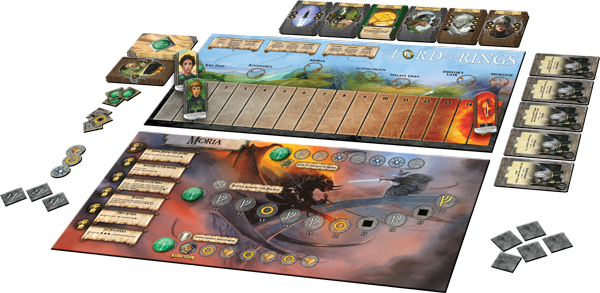It's time once again for another edition of Tabletop Co-Op. Today we will take a look at one of the oldest co-op board games we have covered. Lord of the Rings, originally published in 2000, puts players in the role of the hobbits on their quest to destroy the One Ring and thwart Sauron. The game combines hand management and gorgeous modular boards with a strong cooperative element that lets the theme of the source material shine through.
One clarification before we begin: there are lots of board games based on the Lord of the Rings saga. There are co-ops like the deckbuilding card game which we covered in this column before, competitive games like War of the Ring, and even a "competitive co-op" offering, The Lord of the Rings: Nazgul. The game we have under consideration today is simply titled Lord of the Rings. It was designed by the prolific Reiner Knizia, and has gone through at least two different editions, the most recent being the Fantasy Flight Games Silver Line version, which we will be discussing today.

Obviously, the Lord of the Rings epic has been adapted in games for years. Dozens if not hundreds of different products have lined store shelves, especially in the past decade since the popular movie series concluded. The story lends itself to many different styles, tabletop wargames with dozens of components to massively multiplayer online RPGs. In Knizia's Lord of the Rings, the focus is on the journey of the hobbits from the Shire to Mt. Doom. Up to five players can enjoy the game together, taking on the roles of Frodo, Sam, Merry, Pippin, and a much lesser known hobbit named Fatty.
As the hobbits advance on their journey, a master game board tracks their progress. Each hobbit begins on one side of the board, and a marker representing Sauron is on the other. Throughout the game, the influence of the Ring or other evil forces will cause the hobbits to move closer to Sauron's token. If Sauron ever occupies the same space as whichever hobbit is bearing the Ring, the game ends in defeat. The master game board also tracks progress through the various other locations in the game, which are all represented by modular boards you swap in and out as needed.
On each of the modular boards, there are seperate tracks representing obstacles that must be overcome in order to advance. Fighting, Friendship, Hiding, or Traveling are the four different categories represented. Players cooperate by using the cards in their hands to meet whatever conditions the spaces they land on require. It is a bit abstract, and can be difficult to wrap your head around the first time you play. But once you understand the rules, the cooperative elements of the game really begin to come through.
